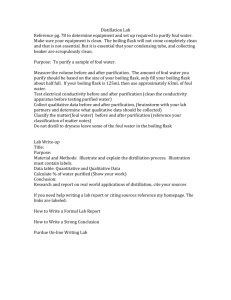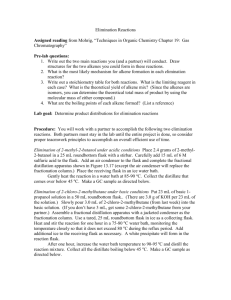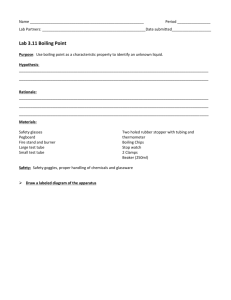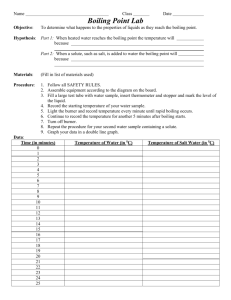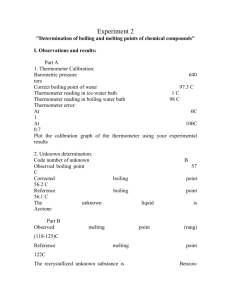reduced pressure boiling
advertisement
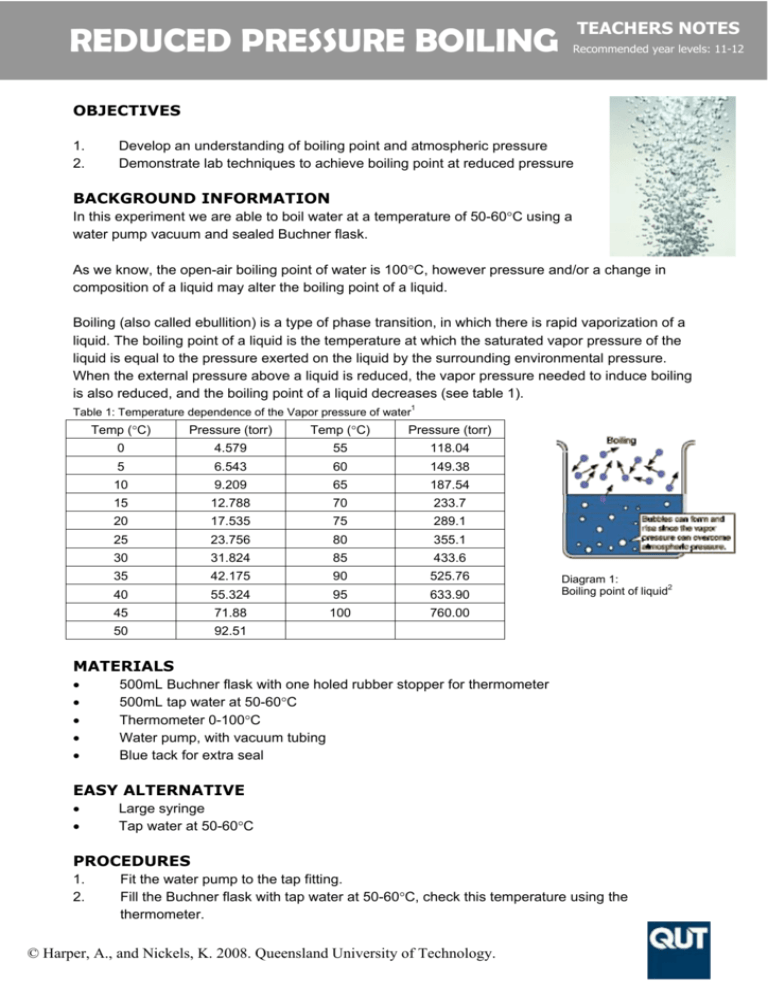
TEACHERS NOTES REDUCED PRESSURE BOILING Recommended year levels: 11-12 OBJECTIVES 1. 2. Develop an understanding of boiling point and atmospheric pressure Demonstrate lab techniques to achieve boiling point at reduced pressure BACKGROUND INFORMATION In this experiment we are able to boil water at a temperature of 50-60°C using a water pump vacuum and sealed Buchner flask. As we know, the open-air boiling point of water is 100°C, however pressure and/or a change in composition of a liquid may alter the boiling point of a liquid. Boiling (also called ebullition) is a type of phase transition, in which there is rapid vaporization of a liquid. The boiling point of a liquid is the temperature at which the saturated vapor pressure of the liquid is equal to the pressure exerted on the liquid by the surrounding environmental pressure. When the external pressure above a liquid is reduced, the vapor pressure needed to induce boiling is also reduced, and the boiling point of a liquid decreases (see table 1). Table 1: Temperature dependence of the Vapor pressure of water1 Temp (°C) Pressure (torr) Temp (°C) Pressure (torr) 0 4.579 55 118.04 5 6.543 60 149.38 10 9.209 65 187.54 15 12.788 70 233.7 20 17.535 75 289.1 25 23.756 80 355.1 30 31.824 85 433.6 35 42.175 90 525.76 40 55.324 95 633.90 45 71.88 100 760.00 50 92.51 Diagram 1: Boiling point of liquid2 MATERIALS • • • • • 500mL Buchner flask with one holed rubber stopper for thermometer 500mL tap water at 50-60°C Thermometer 0-100°C Water pump, with vacuum tubing Blue tack for extra seal EASY ALTERNATIVE • • Large syringe Tap water at 50-60°C PROCEDURES 1. 2. Fit the water pump to the tap fitting. Fill the Buchner flask with tap water at 50-60°C, check this temperature using the thermometer. © Harper, A., and Nickels, K. 2008. Queensland University of Technology. REDUCED PRESSURE BOILING 3. 4. 5. Fit the rubber stopper with thermometer onto the flask. Ensure a tight seal. You can use blue tack to increase the seal around the thermometer. Now turn on the tap and observe what happens to the water in the flask. Note what the temperature reads on the thermometer. ALTERNATIVE 1. Fill the test tube to about 20mL with tap water at 50-60°C. Make sure you do not draw 2. 3. 4. up any air. Place your thumb over the open end of the syringe to make an airtight seal Now quickly pull back on the syringe. Observe what happens. QUESTIONS 1. 2. 3. 4. 5. 6. What happened to the water in the flask when using the water pump? The water started to boil. What happened to the temperature when the water started to boil? It stayed the same. What does the water pump do? The water pump reduces the pressure in the flask. It removes gas molecules from the sealed flask to leave behind a partial vacuum. In this experiment we reduced the atmospheric pressure using a water vacuum. Can you think how else we could reduce the atmospheric pressure? By boiling the water at high altitude. What was the range of vapour pressure created in the flask causing the water to boil (use the table above)? between 92.51 and 149.38. If you were at the top of Mt. Everest at what temperature could you boil a cup of water? (Hint atmospheric pressure at the summit of Mt. Everest is one third that of sea level atmospheric pressure). Atmospheric pressure at the summit of Mt Everest is ~253 torr therefore boiling point of water would be ~70-75°C. REAL WORLD APPLICATIONS OF LIQUID PRESSURE Blood pressure: The heart acts like a pressure pump and uses this pressure to ensure that blood is pumped through our circulatory system. Blood pressure is used as a principal vital sign when determining the health of a person. CURRICULUM CONCEPTS ADDRESSED Physics F4.1 — External forces can change the internal energy of an object. F4.2 — Kinetic theory suggests that matter is made up of atoms that are in continuous random motion. Concepts related to pressure, volume and temperature may be linked to this motion. RESOURCES USED TO DEVELOP THIS ACTIVITY 1. 2. Shakhashiri, B.Z. (1992). Chemical Demonstrations: A handbook for Teachers in Chemistry (2nd Ed). Madison: The University of Wisconsin Press. Hyperphysics. (n.d.) Retrieved November 7, 2008, from http://hyperphysics.phyastr.gsu.edu/Hbase/Kinetic/vappre.html Image courtesy of: www.gettyimages.com © Harper, A., and Nickels, K. 2008. Queensland University of Technology.

